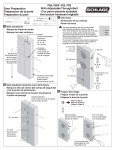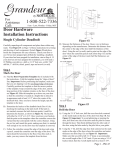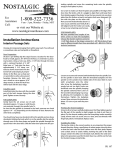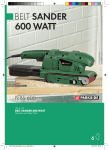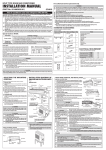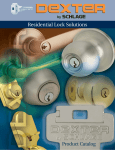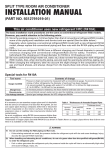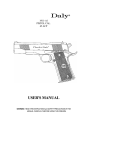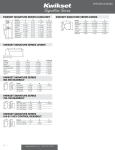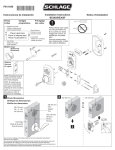Download Grandeur WINFGRVER-70-TB Instructions / Assembly
Transcript
Door Hardware Installation Instructions Handleset - Single Cylinder Version Carefully unpackage all components and place them within easy reach. Find Figure #1A and Figure #1B (exploded drawings with parts listing) at the back of these instructions. Figure #1A is for a longplate style interior, and Figure #1B is for a rosette (round) style interior. Use Part #19 to determine which of these two figures is appropriate for your installation and discard the other to avoid confusion. Place the appropriate Figure #1 for your installation beside the components for easy reference. For the balance of these instructions, we will only refer to this exploded drawing as Figure #1. You will need a #2 Phillips screwdriver for installation of your new doorsets. If the door is not pre-drilled, you will also need a 2-1/8” hole saw, a 7/64” drill bit, 7/32” drill bit, 5/16” drill bit, 7/8” drill bit, and 1” drill bit (spade or forstner style), a chisel, a pencil and an awl (or nail). If your door is pre-drilled start at Step 2. Step 1 Door Preparation A) Find the Entry Door Preparation Templates. Determine if your door is beveled (see illustration on templates). If so, choose the appropriate Entry Door Preparation Template and fold along line B to match the illustration. If your door is not beveled, choose the appropriate Entry Door Preparation Template that will mount on the outside of your door and fold along line B. B) Carefully position the template on the outside of the door so that the line marked A is approximately 36”-38” from the floor, depending on preference of doorknob height. Make sure that the corner of the door is lined up with the fold (line B) and tape the template to the door. IMPORTANT—If your door is prepped with a 2-1/8” hole for the doorknob, match line A with the center of the existing doorknob hole. C) Determine if your “backset” is 2-3/8” or 2-3/4”. If your door is prepped for a lock, the backset is the distance from the edge of the door to the center of the cross-bore hole (see Figure #2). If your door is not prepped, then find the handleset latch (Figure #1, Part #14). Measure the distance from the flange to the center of the star-shaped hub. The distance will be slightly under 2-3/8” or 2-3/4” to allow for adding a faceplate. See Figure #2. If your backset is 2-3/8”, use line C on the template. If your backset is 2-3/4”, use line D. For Assistance Call: 8 am - 5 pm, Monday - Friday, MST or visit our Website at: www.grandeur-nw.com 1-800-522-7336 �� D) Using the awl (or a nail), mark the three intersecting points on the template as indicated below, making sure the door is clearly marked: 2-3/8″ Backset 2-3/4″ Backset or Where lines E & C cross Where lines E & D cross Where lines A & C cross Where lines A & D cross Where lines F & C cross Where Lines F & D cross E) Measure the thickness of your door. Most exterior doors are 1-3/4”, 2” or 2-1/4” thick. Once you have measured the thickness, mark the points on the edge of the door where lines A and E intersect with your appropriate door thickness line. F) With the template still on the door, close the door. Using a pencil, lightly mark on the door jamb where lines A and E meet the jamb. Find the Door Jamb Template and fold along line BB. Once the template has been folded, place it against the door jamb so that the folded edge matches up with where the edge of the door sits when closed. Match lines AA and EE to the marks you made from lines A and E. Once aligned, tape the Door Jamb Template to the door jamb. Find the four points where lines 1, 2, 3, & 4 cross the correct door thickness. Using the awl (or a nail), mark these four points on the jamb. G) Verify that all marks can be clearly seen on the door and door jamb and remove both templates. H) Using Figure #3 and the marks made in Step 1D as a reference, drill the two 2-1/8” cross-bore holes using a hole saw. IMPORTANT—To avoid damaging the door, drill from one side until the pilot bit comes through the door. Then finish drilling from the other side, using the pilot hole as your guide. IMPORTANT—Always drill as straight or level as possible to ensure proper door preparation. I) Using Figure #3 as reference and the marks made in Step 1E, drill the two 1” edge-bore holes. Make sure that you drill a full 3-7/8” deep for 2-3/8” backset, or 4-3/8” deep for a 23/4” backset, which will extend beyond the cross-bore holes. ��������� ����� ������������ ���������� ����� ������������ Flange Star-shaped hub Figure #2 Figure #3 Page 1- PK161 J) Using Figure #3 and the mark made in Step 1D as reference, drill one 7/32” hole all the way through the door at point M. K) Using the faceplates (Parts #2 & #15) as templates and a pencil to mark with, line up the faceplate for the deadbolt (Part #2) with the top edge-bore hole on the door and lightly mark a line around the faceplate. Then, using a chisel, mortise out a 1/8” deep area to allow the faceplate to sit flush with the edge of the door. Repeat this step with the faceplate for the latch (Part #15) on the bottom edge-bore hole. See Figure #3. Step 2 Install the Deadbolt Latch A) Find the Deadbolt Latch (Part #1). Use a screwdriver to extend the deadbolt (Part #1A). Insert the latch into the top edge-bore hole, making sure that the latch is oriented correctly with the “+” on the lower portion of the latch. See Figure #4. Step 3 Install the “Outside” Half of the Deadbolt A) Using Figure #1 for reference, gather together the cylinder assembly (Part #4), spin ring on longplate installations (Part #5A), the escutcheon (Part # 5 or #5B), the deadbolt adaptor plate (Part #6), the security ring (Part #16), and two 2-3/4” machine screws (Part #7). Part #5A is not used or required for a rosette installation. B) Place the spin ring over the cylinder driver bar (Part #4A) end of the cylinder, making sure that the narrower edge of the spin ring is closest to the key hole end of the cylinder. Insert the cylinder assembly through the spin ring and escutcheon. On the back of the escutcheon, slip the narrow end of the security ring (Part #16) onto the cylinder assembly as shown in Figure #5. Deadbolt (Part #1A) ���������� ������������� Deadbolt Latch (Part #1) Deadbolt Faceplate (Part #2) ���������� ��������������� ��� Handleset Latch (Part #14) ��� Figure #5 Latch Bolt (Part #14A) Figure #4 Rotate latch bolt so curved surface faces door jamb. Latch Faceplate (Part #15) 3/4” Latch & Strike Wood Screws (Part #3) B) Place the faceplate for the deadbolt (Part #2) over the deadbolt and make sure that it sits flush in the mortised out area on the edge of the door. Note: some doors come prepped with rounded corners in the mortised out area. If your faceplate does not sit flush, simply use a chisel to square off the corners so that the faceplate for the deadbolt sits flush with the edge of the door. C) Drill the latch screw holes with 7/64” drill bit at least 3/4” deep. Having too small a hole can cause the screws to shear off. D) Install two 3/4” latch & strike wood screws (Part #3) through the faceplate and deadbolt latch to hold them both in place, as shown in Figure #4. TIP: for ease of installation, add soap to the screw threads. C) From the outside of the door, insert the cylinder driver bar (Part #4A) through the “+” in the deadbolt latch housing, making sure that the driver bar is oriented vertically with the deadbolt extending from the edge of the door. If done correctly, the outside assembly should hold itself in place temporarily. D) Make sure that the cross bore hole will be completely covered by the escutcheon and that the Grandeur logo is oriented correctly. E) On the inside of the door, place the deadbolt adaptor plate (Part #6) so that the beveled screw holes face away from the door and line up with the corresponding holes on the cylinder assembly. Screw in the two 2-3/4” machine screws (Part #7) to hold the outside assembly in place, see Figure #6. Do not fully tighten yet. F) Align the escutcheon and cylinder with the door edge and snug the two machine screws down. Do not over tighten. G) Using the key, unlock and re-lock the latch to make sure that the action is smooth. If the screws have been over tightened, the latch may bind. Once the action is acceptable, move on to Step 4. Page 2 - PK161 the door is closed, you can cover the end of the bolt with a light amount of lipstick or similarly visible material. When you turn the thumbturn, the lipstick will mark the door jamb. Measuring in from the “door stop trim”, identify the center mark where the bolt hole needs to be drilled, see Figure #8. B) Using a 7/8” drill bit, drill two holes centered 5/16” above and below the center mark. These holes will overlap. Make sure each one is at least 1-1/8” deep. Figure #6 Step 4 Adding the Inside Thumbturn Assembly C) Clean out the hole (if needed) and insert the dust box (Part #10). Close the door carefully, making sure not to crush the dust box. Make sure that the deadbolt and dust box line up. If not, carefully enlarge the hole as needed. �������� ���������� ���������� ���������� ���������� A) Using Figure #1 for reference, gather together the thumbturn assembly (Part #8), and the two 5/8” machine screws (Part #9). ����� ����� ���� B) Install the thumbturn assembly such that the cylinder driver bar (Part #4A) comes through the latch housing and is inserted into the slot on the back of the thumbturn. C) Align the holes on the thumbturn assembly with the two small holes on the adaptor plate. See Figure #7. �������� ������������� �������� ��������� ��������� �������� ��������� ���� ������������������ ��������� ���� �������������� ��������� �������� ���������� Figure #7 D) Install the two 5/8” machine screws, making sure that the plate is positioned correctly before tightening the screws. Do not over-tighten the screws. E) Turn the thumbturn and the key separately to make sure that the action is smooth. If the screws have been over-tightened, the latch may bind. Once the action is acceptable, move on to Step 5. Step 5 Installing the Door Reinforcer and Strike Note: If door jamb is already drilled, go to Step 5E below. A) With the deadbolt in the unlocked position, close the door. From the inside of the house, turn the thumbturn and identify where the bolt is contacting the door jamb. Lightly mark this with a pencil on the door jamb. Note: This should correspond with the marks made in Step 1F. Hint: If you cannot see the bolt clearly, or cannot mark the jamb with a pencil because ������������ ���������� �������� ������ ���������� ������������ ����������������������������� Figure #8 D) Using the strike plate (Part #13), mark the area to be mortised out for the dust box (Part #10), the door frame reinforcer (Part #11), and the strike plate. Use a chisel to mortise this area 3/16” deep and make sure that once assembled, the strike plate sits flush to the door jamb. E) Insert the dust box and place the door frame reinforcer over the dust box. Using the door frame reinforcer as a guide, find the holes closest to the outside of the house and drill two 7/64” x 3” deep holes for the reinforcer screws. See Figure #8. F) Install the door reinforcer using the 3” wood screws (Part #12). Again, check to make sure the deadbolt and reinforcer line up and that the deadbolt can be locked. G) Place strike plate over door frame reinforcer and drill two 3/4” deep holes (using the 7/64” drill bit) for the strike plate and install the strike plate using the 3/4” latch and strike wood screws (Part #3). Again, check to make sure the deadbolt, reinforcer and strike plate line up and are flush with the door jamb and that the deadbolt can be locked. Step 6 Install the Handleset Latch A) Once your door is prepped for installation, you will need a #2 Phillips screwdriver, a drill, and a 4” x 7/64” drill bit for the installation of your new doorsets. B) Locate the handleset latch (Part #14) and the anti-rotation Page 3 - PK161 block (Part #27). The anti-rotation block is only used with a Rosette interior. Insert the anti-rotation block into the cross bore hole (Figure #3) so that the arrow on the block is pointing toward the edge of the door. Install the handleset latch into the edge bore hole (Figure #3), making sure that it is correctly inserted through the anti-rotation block. When installed correctly, the star-shaped hub in the latch should be centered in the hole of the anti-rotation block, see Figure #9. ����������� ��� ������������� ����� ���������� ����������������� ����� ���������� ����������� Figure #9 C) Determine which direction the door will swing when it is being opened. Rotate the latch bolt (Part #14A) so that the flat edge of the bolt faces toward the direction the door swings when being opened (and the round edge towards the doorjamb). Once oriented correctly, place the faceplate (Part #15) over the latch bolt, locking the latch bolt orientation. Note: some doors come prepped with rounded corners in the mortised out area. If your door is prepped like this, simply use a chisel to square off the corners so that the faceplate for the handleset sits flush with the edge of the door. E) Drill the latch screw holes with 7/64” drill bit at least 3/4” deep. Having too small a hole can cause the screws to shear off. F) Install two 3/4” latch & strike wood screws (Part #3) through the faceplate and handleset latch to hold them both in place. TIP: for ease of installation, add soap to the screw threads. Step 7 Installing the Exterior Grip-set and Inside Trim Determine if you will be installing a rosette or a longplate on the inside of the door, and go to either Step 7A for Rosettes or Step 7E for Longplates. Rosette Version A) Using Figure #1 for reference, gather together the exterior handleset (Part #17), the inside rosette assembly (Part #19), the lower mounting screw (Part #23) and the rosette mounting screws (Part #20). Note that there are two lengths of rosette screws provided, one 1-1/2” pair and one 2” pair. The majority of doors will use the shorter screws (11/2”), so try these first and only use the longer screws if the shorter ones do not work. Insert one of the screws through the top hole in the rosette assembly and set this aside within easy reach. Carefully place the handleset in position on the outside surface of the door, such that the handleset spindle (Part #17A) is seated in the star-shaped hub of the latch, see Figure #10. When seated correctly, you will be able to hold the handleset in place and depress the thumbpiece to retract the latch. B) While holding the handleset in position on the outside of the door, install the lower mounting screw (Part #23) through the screw cover adaptor (Part #22) and tighten snugly, but do not overtighten. If your door thickness is 1-3/4” then the 2-1/4” long screw should be sufficient. Any door thicker than 1-3/4” will require the 2-1/2” screw length to be used. Thread the mounting screw cover (Part #24) onto the screw adaptor cover. C) Place the rosette assembly in position on the inside of the door, and insert the rosette mounting screw (Part #20) into the top screw boss on the back of the handleset, see Figure #10. Tighten and screw down until almost snug. Insert and tighten down the second rosette screw into the lower screw boss. Align the handleset on the outside of the door for appearance and snug down both rosette screws. Do not overtighten. If your interior set is a knob, go to Step 8. ����������������������� ������������� ����������������� ��������� Figure #10 D) If your interior set includes a lever see Figure #11 for lever orientation. Your lever will only rotate in one direction. It is designed to rotate downward. If your lever rotates upward, please call customer service at 1-800-522-7336. Longplate Version E) Locate the exterior handleset (Part #17), the mounting plate (Part #18), the lower mounting screw (Part #23) and the mounting plate screws (Part #21). Insert one of the mounting plate screws through the top hole in the mounting plate and set this aside within easy reach. Note that there are two lengths of mounting plate screws provided, one 1-1/4” pair, and one 1-3/4” pair. The majority of doors will use the shorter screws (1-1/4”), so try these first and only use the longer screws if the shorter ones do not work. Carefully place the exterior handleset in position on the outside surface of the door, such that the spindle (Part #17A) is seated in the star-shaped hub, see Figure #10. When seated correctly, you will be able to hold the handleset in place and depress the thumbpiece to retract the latch bolt. F) While holding the handleset in position on the outside of the door, install the lower mounting screw (Part #23) through the screw cover adaptor (Part #22) and tighten snugly, but do not overtighten. If your door thickness is 1-3/4” then the 2-1/4” long screw should be sufficient. Any door thicker than 1-3/4” will require the 2-1/2” screw length to be used. Thread the mounting screw cover (Part #24) onto the screw adaptor cover. Page 4 - PK 161 G) With the handleset now in place on the outside of the door, place the mounting plate (Part #18) and mounting plate screw (Part #21) in position on the inside of the door, insert the screw into the top retention boss and tighten until almost snug. See Figure #11. Insert and tighten the second screw into the lower boss. Align the handleset on the outside of the door for appearance and tighten the screws until snug. Do not overtighten. If your interior set includes a lever see Figure #11 for lever orientation. Your lever will only rotate in one direction. It is designed to rotate downward. If your lever rotates upward, please call customer service at 1-800-5227336. ��������� ����� Correct Lever Orientation (Lever Rotates Downward) L) Following Step 7I and 7J again, re-attach the interior longplate, using the clear alignment jig to protect the door from scratching. Then, using the 1” wood screws (Part #20), secure the longplate to the door snugly, but do not overtighten the screws. Make sure that the screwdriver does not scratch the doorknob or longplate. Step 8 Prepare the Doorjamb and Install the Strike ���������� ������ Door Edge Incorrect Lever Orientation ������������������������� ������������������������ ���� ��������� ��������� Figure #11 H) Using Figure #1 as your guide, gather together the interior longplate (Part 19), 1” wood screws (Part #20), clear alignment jig (provided), Phillips screwdriver, drill, awl (or nail), and the 4” x 7/64” drill bit (provided). I) the edge of the door. Using an awl (or nail), mark the screw holes on interior longplate and remove it from the door. Drill the screw holes 3/4” deep, using the 4” x 7/64” bit provided. Important: Depending on the design that you are installing there will either be two or four screw holes in each plate. All screws must be installed to secure the longplate to the door. Place the clear alignment jig on the inside of the door where the interior longplate will be installed, see Figure #12. Place the interior longplate on the door, so that the spindle is inserted into the star-shaped hub of the latch and the retention bosses nest in the wide end of the teardrop slots in the mounting plate, see Figure #11. J) The interior longplate will be out of alignment when you first get the retention bosses into the teardrop slots. When the retention bosses are fully seated, the interior longplate will be flush to the face of the door. Gently twist the interior longplate clockwise until it is parallel with the edge of the door, being sure not to scratch the door when you are twisting the longplate, see Figure #12. Carefully slip the clear alignment jig out from under the interior longplate. The interior longplate should hold itself on the door at this point. A) Using Figure #1 for reference, gather together the strike plate for handleset (Part #26), two 1” latch and strike wood screws (Part #3), a drill, 1” drill bit, the awl (or nail), 4″x7/64” drill bit, the pencil and chisel. B) Rotate the knob or lever to retract the latch bolt and carefully close the door, making sure that the latch bolt is fully retracted and does not scratch the doorjamb. Slowly release the knob/ lever and let the latch bolt extend against the doorjamb. C) Using the pencil, lightly mark the door jamb at the level of the top and bottom of the latch bolt (Part #14a). These need to be light marks, so that they can be erased later if needed. Turn the knob/lever again to retract the latch bolt and re-open the door. Now extend the marks so that they are approximately 3/4” from the edge of the door stop trim where the door stops when it is closed, See Figure #13. D) Repeat Step 8B, and verify that the latch bolt is falling between the two marks. E) Measure the thickness of the door. Take half of the door thickness and measure that same distance from the edge of the door stop trim where the door stops when it is closed. Mark on the door jamb this distance halfway between the two lines from Step 8C, see Figure #13. ����� ���� ���������� ���� ���������� ������� ��������������� ��������������� ���������� ������������������� ���������� ������� ����� ��������� ��������� ��������� ������ Figure #13 ������������� Figure #12 K) Using the clear alignment jig, check to make sure that both the interior longplate and exterior handleset are aligned to F) Using the awl, mark where the point that is halfway between the two lines made in Step 8C crosses the line marked in Step 8E. Page 5 - PK 161 G) Using a 1” drill bit, drill a hole centered on the mark from Step 8F. Make sure the hole is at least 5/8” deep. Clean out any sawdust from the hole. H) Using the strike plate for handleset (Part #26) as a template, center the strike over the 1” hole, mark a line around it in pencil and remove from doorjamb. I) Using the chisel, score the outline of the strike. Next, chisel away the material within the outline to a depth of 1/16”. When you are done, you should be able to place the strike in the mortised out area and it should be flush with the doorjamb. J) Again, using the strike as a template and the awl as a marking tool, mark the two screws holes that will hold the strike on the door. Remove the strike from the doorjamb to avoid marring the finish. Then, drill the two screw holes using the 4” x 7/64” drill bit. Make sure the holes are drilled at least 3/4” deep. Having too small or too shallow of a hole can cause the screws to shear off. K) Install the dustbox and fasten the strike in place using two 3/4” latch & strike wood screws (Part #3) Hint: Coating the screw threads with a small amount of soap (liquid or bar soap) will make installation easier. Congratulations! You are now on your way to enriching your life with ! Page 6 - PK 161 ����� ������������� �������������������������� �� ���������������������� ���� ���������������� �� ������������������������������ �� ������������������������������������������� �� ������������������������� ��� ��������������������������� ��� ����������������� ��� ������������������ �� ������������������������������ �� ������������������������������ �� �������������������������� �� ������������������������������� ��� ���������������������������� ��� ����������������������������� ��� �������������������������� ��� ��������������������������������� ��� ����������������������� ���� ������������������� ��� ��������������������������� ��� ��������������������� ��� ������������������������� ���� ������������������������� ��� ���������������������� ����������� �������������������������� ��� ���������������������� ��� ����������������������������������������� ��� ��������������������������� ��� ���������������������������������������� ��� ���������������������������� ��� ����������������������������� ��� ���������������������������������� �������������������������������� ����� ������������� �������������������������� �� ���������������������� ���� ���������������� �� ������������������������������ �� ������������������������������������������� �� ������������������������� ��� ��������������������������� �� ������������������ �� ������������������������������ �� ������������������������������ �� �������������������������� �� ������������������������������� ��� ���������������������������� ��� ����������������������������� ��� �������������������������� ��� ��������������������������������� ��� ����������������������� ���� ������������������ ��� ��������������������������� ��� ��������������������� ��� ������������������������� ���� ������������������������� ��� ������������������������������������������� ����������� ������������������������ ��� ������������������������������������������� ��� ������������������������������������������� ��� ��������������������������� ��� ���������������������������������������� ��� ���������������������������� ��� ����������������������������� ��� ���������������������������������� ��� ��������������������������� ������������������������������









